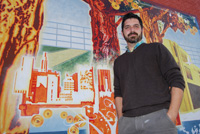Editorial
Front Page - Friday, November 19, 2010
Chattanooga murals express community values
David Laprad
 Chattanooga muralist Shaun LaRose stands beside a mural he painted on the side of a building on West Main and Mitchell. The wall painting encapsulates the nature of the city by combining various industrial and agrarian images into a cohesive whole.
- David Laprad
Chattanooga muralist Shaun LaRose stands beside a mural he painted on the side of a building on West Main and Mitchell. The wall painting encapsulates the nature of the city by combining various industrial and agrarian images into a cohesive whole.
- David Laprad
Long before Michelangelo chiseled David out of marble or Leonardo da Vinci gave Mona Lisa her enigmatic smile, primitive man etched murals into the walls of caves. The crude pictures might not have been great art, but they did express the values of the people who created them. While murals evolved as an art form over time, their purpose remained the same: to visually articulate the things that make a group of people who they are.
Consider the mural near the intersection of West Main and Williams. Painted by Chattanooga muralist Shaun LaRose, it features Main Street icons of the past and present.
“This area has seen lots of ups and downs culturally over the last 50 years. I wanted to chronicle that and celebrate what’s going on now,” LaRose says as he bites into a cinnamon roll at Niedlov’s Breadworks.
While the new owners of the building have considered painting over the 40-by-30 foot work of art, LaRose says that would be tragic, not because the work is his, but because murals are an important part of a culture’s artistic landscape.
“No one will remember I painted the mural because my styles are across the board. I’ll do traditional, classical, realistic and then something that’s completely off the grid. Murals are about the community in which they were painted, not the artist,” LaRose says.
Even the process of creating a mural can involve the community of which it will be a part. As such, LaRose encounters obstacles other artists, who work in isolation, do not. For example, to create the wall painting on West Main and Williams, LaRose labored for two years to secure permission from the owners of the building.
The resistance he encountered stemmed from misperceptions in the business community that a mural is a product of a group of people slapping paint on the side of an edifice.
“That’s not the case. It takes a sizeable budget to do a mural well. You have to sandblast the surface so your mural won’t peel along with the old paint, and then seal it several inches deep so moisture won’t come through and bubble the paint. A mural also has to be UV light protected and varnished to keep the elements off,” LaRose says.
By the time LaRose convinced the owners of the building to let him do the piece, and secured the money for the work from the Bentwood and Lyndhurst Foundations, the business vacated the building. When LaRose contacted the new owners, they thought he was “some crazy guy off the street who wanted to paint the side of their building.”
Not all of LaRose’s community interactions have been as backbreaking. His current project is a mural he plans to paint along a retainer wall going into a tunnel in East Ridge. At the onset of the endeavor, he met with the local city council and asked for its input. He’s currently creating the final design.
“It’s been a great process. It brought people together to identify their values and the things that were important to them,” he says.
While LaRose believes his work has value, he avoids placing too much importance on his murals.
“The baker who runs this place is contributing far more to the community than I am. Nothing makes an artist more significant than the people who are doing everyday jobs,” he says.
People who work normal jobs earn a steady income, though, and LaRose supports a wife and five children on an occasional paycheck, which imbues his work with a measure of sacrifice. Even so, he refuses to over romanticize what he does.
“While I’m passionate about murals, if I had another skill set that would be better for my family, I’d do that instead. It’s not like this is a dream, and we’re going to follow it come hell or high water,” he says.
While LaRose misses the good money he was making in Minneapolis, Minn., as a high-end decorative painter and muralist, he and his wife, Sember, are committed to making a life in Chattanooga.
“People come here with a zeal for something and then go through a period of boot camp. We spent four years going through the ringer. It took everything in us to not pack up and move back to Minneapolis. We just felt like it wasn’t time to leave,” LaRose says.
This year has been good for LaRose, and the project in East Ridge appears to have energized him, ensuring he’ll remain in Chattanooga for the foreseeable future. This gives the people of the Scenic City an opportunity to create art on a large scale that conveys to future generations the ideas and values that made them who they are. The only question: Is there a building face in Chattanooga large enough to contain this vision?
To learn more about LaRose, who also designed the set for the performance of “Amahl and the Night Visitors” at the Tivoli earlier this month, visit www.shaunlarose.com.
|
|